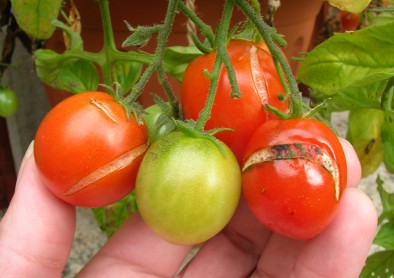Why Tomatoes Split and How To Avoid It Happening
This is about the time of the season when ripe tomatoes begin to split. If the problem is severe, it’s possible to have an entire truss of tomatoes with split skins!
We know that tomato plants lose a lot of moisture (through transpiration) when the weather is hot and they need a lot of water to prevent them from wilting. They also need to keep fully pressurised – a bit like a bicycle tyre, pumped-up (turgid). Although the amount of pressure in a plant varies, even from morning to evening, the variation is usually slight and plants cope OK.

A Sudden Downpour
However, in hot weather, when plants are using and losing a lot of moisture, the pressure variation can be much wider causing tomato skins to burst – when pressure suddenly increases owing to a downpour of rain for example.
In the other extreme, tomato skins can become wrinkly as moisture is diverted from the tomatoes back to the stem and leaves of a plant.
Although the later case is unusual, it does happen in hot conditions, when plant are struggling to keep turgid, and mainly effects tomatoes with more moisture content.
Watering frequency
For outside tomatoes, a sudden downpour of rain is often the reason why tomatoes split – because of excess moisture causing pressure and split skins.
For tomatoes grown under cover, the cause of split skins is usually infrequent watering when temperatures are high.
The watering frequency required to avoid the problem depends on the amount of moisture the growing medium, usually soil, can hold – as well as temperatures of course.
A Cause of Blossom End Rot
When water availability is low, moisture that would normally go to the fruit is diverted back to the plant in order to keep it pressurised (turgid). When this happens calcium and other nutrients are withheld from the fruit and blossom end rot is likely to occur.
Wide swings in moisture availability can cause BER as well as split fruit.
Double Stemming
One way to help reduce the problem is to grow two main stems on each plant – especially on varieties prone to splitting. This has the advantage of having a greater internal capacity and therefore plants are less prone to sharp rises in internal pressure that split ripe fruit.
I found this to be particularly useful when growing Sungold.
Another Issue When Avoiding Split Skins is Container Size
For example, basic potting compost in a 10 litre pot will need watering more frequently than a plant growing in a 50/50 compost and perlite mix in the same size pot. The plant in the basic potting compost will also be more vulnerable to split skins and BER.
The 50/50 soil and perlite mix can hold more water, will take longer to dry out, and consequently, needs watering less often. As just mentioned, the tomatoes grown in it will be less vulnerable to BER and split skins – not to mention other water stress problems.
Are Bigger Pots Better?
Am I suggesting that bigger pots with added perlite are better … no … I’m suggesting that bigger pots with a medium that holds plenty of moisture are easier to manage. If you have a system of watering, such as a reservoir beneath a pot, the pot size and ability of the soil etc. to hold moisture is less critical.
Rockwool as an Example
An extreme example is a 3 inch rockwool block. I used to grow dwarf varieties such as Vilma, Micro Tom and Heartbreaker, in my porch, in 3×3 inch rockwool blocks. The size of the growing area isn’t important if the medium (in this case rockwool) is watered and fed correctly.
Rockwool holds a lot of moisture as well as air and it looks a bit like loft insulation. I would encourage everyone to have a go at growing a small dwarf variety in a rockwool block on the windowsill next season – it’s a great learning experience!
To Sum Up
If you suffer from split skins or blossom end rot here are a few tips for next season.
- The most important point is to make sure that the soil, or whatever you are growing your plants in, doesn’t fully dry out.
- Larger pots are safer – they hold more moisture and take longer to dry out. Larger pots with added perlite etc. are even better!
- Smallish pots with economy potting compost are the worst combination.
- Medium size pots over a reservoir with perlite are very good – the reservoir provides a constant water supply and the perlite provides plenty of oxygen.
I hope that you’re ripe tomatoes haven’t started to split.


robert smith
just a quickie to say how much I enjoy and find very interesting your weekly bulletins, I am fairly new to tomato growing and have a lot to learn I just wish I had discovered your column sooner, however I have now and will be looking forward to next year’s tomato growing season when I can act on all the valuable advice you very kindly provide, please continue with your column it is very much appreciated.
richard
if only we had the weather!